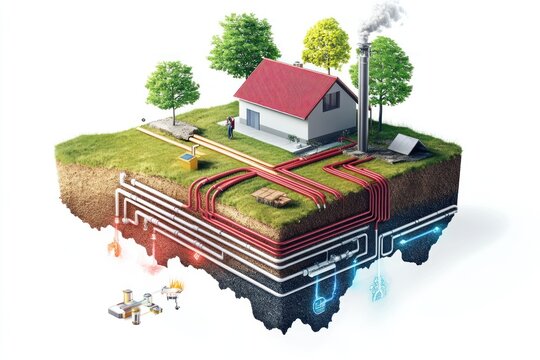Overview
Geothermal energy is derived from the Earth's internal heat, originating from the planet's formation and the radioactive decay of minerals. This heat is accessible through natural geothermal reservoirs or by enhancing subsurface permeability to create engineered systems.
Electricity Generation
Geothermal power plants convert the Earth's heat into electricity through several methods:
- –
Dry Steam Power Plants: Utilize steam directly from underground reservoirs to drive turbines.
- –
Flash Steam Power Plants: Extract high-pressure hot water from the ground, which rapidly vaporizes (flashes) into steam to power turbines.
- –
Binary Cycle Power Plants: Transfer heat from geothermal fluids to a secondary fluid with a lower boiling point, which then vaporizes to drive turbines.
These plants provide consistent, baseload power, operating 24/7 regardless of weather conditions. Notable examples include The Geysers in California, the world's largest geothermal field, and Iceland's extensive geothermal infrastructure, which supplies a significant portion of the country's electricity.
Direct Use Applications
Beyond electricity generation, geothermal energy serves various direct applications:
- –
District Heating Systems: Cities like Reykjavik, Iceland, utilize geothermal heat to provide heating and hot water to multiple buildings through a network of pipes.
- –
Greenhouse Heating: Geothermal energy maintains optimal temperatures in greenhouses, enabling year-round agriculture even in colder climates. For instance, in Kenya, geothermal heat supports flower production by controlling humidity and temperature within greenhouses.
- –
Aquaculture: Fish farms use geothermal heat to maintain ideal water temperatures, enhancing fish growth rates and production efficiency.
- –
Industrial Processes: Industries employ geothermal heat for processes such as drying lumber, pasteurizing milk, and drying crops, reducing reliance on fossil fuels and lowering operational costs.
Geothermal Heat Pumps (GHPs)
Geothermal heat pumps exploit the relatively stable temperatures beneath the Earth's surface to provide heating and cooling for buildings. By circulating a fluid through underground pipes, these systems transfer heat to or from the ground, offering energy-efficient climate control for residential and commercial structures.
Enhanced Geothermal Systems (EGS)
Enhanced Geothermal Systems involve creating artificial reservoirs by injecting fluid into hot, dry rock formations to extract heat. This technology expands geothermal energy's potential by enabling resource development in regions lacking natural reservoirs. EGS projects are under development in countries like Australia, France, Germany, Japan, Switzerland, and the United States.
Environmental Considerations
Geothermal energy is generally considered environmentally friendly, emitting significantly lower greenhouse gases compared to fossil fuels. However, geothermal fluids can contain trace amounts of gases such as carbon dioxide, hydrogen sulfide, methane, and ammonia. Proper management and emission-control systems are essential to mitigate these emissions and prevent environmental harm.
Global Developments
Geothermal energy is gaining attention worldwide as a sustainable energy source. The European Union is promoting geothermal projects to enhance energy security and reduce reliance on fossil fuels. In the United States, companies like Sage Geosystems are developing innovative geothermal technologies, leveraging expertise from the oil and gas industry to advance the sector.
Conclusion
Geothermal energy offers a renewable, reliable, and versatile energy source with applications ranging from electricity generation to direct heating and industrial processes. Continued technological advancements and supportive policies are crucial for expanding its utilization and contributing to global energy sustainability.
